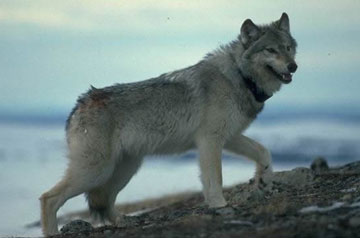First wolves killed in Wyoming after species loses ESA protection
First wolves killed in Wyoming after species loses ESA protection
Jeremy Hance, mongabay.com
April 2, 2008
One of the wolves was well-known to researchers
|
|
In one of a series of controversial decisions regarding the Endangered Species Act recently, the federal government has dropped the Rocky Mountain grey wolf from the program. The announcement of the de-listing was made in mid-February, but did not go into effect until Friday when the reins of control were handed over from the federal government to the individual states. Over the weekend wolf-hunting began in Wyoming.
Three wolves have been reported killed in Wyoming since Friday, though the number may climb higher since hunters have ten days to report a kill. According to an article in The Salt Lake Tribune one of the wolves had a tracking collar, and has been identified as 253M, an eight-year-old male who was tagged in Utah three years ago and then moved to Yellowstone National Park. The wolf was shot legally outside the park. In Wyoming’s ‘predator zone’ a wolf can now be killed at any time for any reason, so long as the kill and its details are reported. No permit or license is required.
Hunting season will begin in Idaho and Montana in the fall; in the meantime people can kill any wolf they deem bothersome, namely if it is harassing livestock or pets. Wolf trapping seasons are under consideration.
 Courtesy of USGS |
The hunting is not going unnoticed by scientists and conservationists. A group of twelve environmental organizations are planning to sue the federal government, arguing that the wolf population is still too small to be considered safe from a second-round of regional extinction. Genetically-healthy wolf populations are not measured on totals, but on the number of breeding pairs, since only the alpha male and female breed in each pack. The environmental organizations argue that to have a healthy population in the Rocky Mountains the grey wolf needs at least 2,000-3,000 individuals. Currently, the population of wolves in the Rocky Mountain area is around 1,500. Based on twenty-year old recovery plans for the species the federal government could allow wolf populations to drop to 300 before stepping in.
The wolf used to be one of the most common large predators in North America. Historical populations in the lower forty-eight have been estimated at 400,000. Currently, there are probably almost six-thousand wolves in the same area: the Great Lakes states include around 4,000, and the Rockies 1,500. Alaska’s population, where the wolf is widely hunted, has been estimated between 6,000-11,000 wolves. The wolf is still protected in the Southwest, where its subspecies, the Mexican wolf, has been reintroduced into the wild in Arizona and New Mexico. Efforts there to establish a self-sufficient population has met with little success.